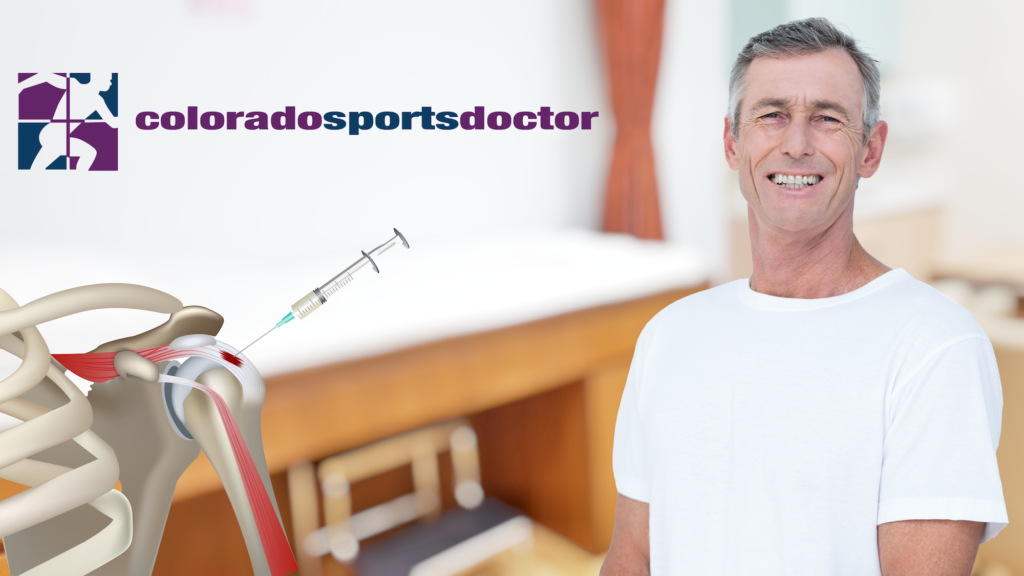
Platelet Rich Plasma (PRP) – What Are the Shoulder Applications?
While PRP therapies are still considered experimental by the vast majority of insurances, clinicians are continuing to expand its applications as we are seeing excellent results utilizing it as a treatment for a wide variety of conditions.
The impetus for exploring these treatments is out of frustration for our inability to offer these patients a “fix”.
As surgeons, we are tasked with fixing problems. When we have to look at patients and tell them that there is nothing we can do to help them and see the disappointment on their faces, we feel like we have failed them.
PRP is a sample of the patient’s blood that is cleaned of all red blood cells (and white blood cells in some preparations) by centrifugation, and contains a higher concentration of platelets per milliliter.
Platelets contain many growth factors that help promote healing by initiating new tissue growth and new blood vessel development in areas that have very little potential for natural healing.
Additionally, platelets contain anti-inflammatory proteins that can be very helpful in alleviating the pain associated with arthritis.
PRP has been shown to have several applications for treating shoulder problems. Some of the primary applications in the shoulder include treatment of:
- Shoulder arthritis
- Rotator cuff tears
- Adhesive capsulitis (frozen shoulder)
PRP Injection for Shoulder Arthritis
Arthritis is a condition where the cartilage surfaces of the joint are damaged. Cartilage covers the surfaces of the bones where they come together to form a joint. The cartilage serves to provide a smooth surface that allows the joint to glide freely without any friction. It also serves as a protective layer that prevents forces to be transmitted to the bone. Since cartilage does not have nerve endings, an intact joint can move freely without pain.
The bone underlying the cartilage (subchondral bone) is rich in nerve endings, therefore, when the cartilage is damaged, the forces through the joint are transmitted directly to this bone. This results in activation of these nerve endings and results in pain. Further, once cartilage begins to break down local factors are activated that initiate inflammation and other enzymes (matrix metalloproteinases) that further degrade and breakdown cartilage. This cascade is progressive and results in loss of joint function and pain.
PRP is effective in treating arthritis by releasing growth factors effect that inhibit inflammation and cartilage breakdown.
There is some laboratory evidence that these growth factors can also stimulate cartilage healing and regrowth. However, we do not believe that PRP alone can reverse all of the damage that has been occurred. The goal of these treatments is to diminish the symptoms of arthritis and perhaps slow down the progression of the degenerative process. This is particularly important in younger patients who would like to delay total shoulder replacement.
Although there are limited peer reviewed studies documenting the beneficial effects specifically in the shoulder, there are numerous randomized controlled trials in peer reviewed journals that show the positive outcomes in treating knee arthritis. Since the pathological process is similar, we can deduce that similar effects will be seen in other joints.
My own experience in treating patients with shoulder arthritis is extremely positive.
The number one variable that effects a patient’s outcome is the severity of arthritis. Patients who present with Grade 4 changes on X-Rays and/or severe limitation of motion are less likely to improve. These patients may be a candidate for a combined approach of arthroscopic releases to improve motion along with PRP therapy.
I typically recommend a series of 3 injections for these patients spread out over 3 to 6 weeks.
PRP Injection for Rotator Cuff Tears
Full thickness rotator cuff tears are tears of the rotator cuff tendons where the tendon is completely detached from the bone. These tears have no potential for healing without surgical repair. These tears almost never occur due to a single traumatic event, but occur after a lifetime of injuries that cause microscopic partial tears that ultimately accumulate to result in a complete tear.
It has been unequivocally shown that these tears occur due to their inability to heal these partial tears. This lack of ability to heal is the result of the rotator cuff having very poor blood supply. Without blood, the necessary components for healing cannot get to the area of injury.
Patients often present to a shoulder surgeon at some time point along this injury spectrum with pain and dysfunction. Evaluation of their shoulder often shows severe tendon degeneration or a partial tear.
This is one of those frustrating situations for the surgeon and the patient where we do not have many options for them. We thoroughly understand this process and know where this patient is headed. Often times, physical therapy along with activity modifications can result in symptom improvement, but the degenerative process will continue. We can only hope that they will not ultimately completely tear the rotator cuff.
This situation is one where utilizing PRP to treat the tendon can potentially improve the quality of the tendon and potentiate healing.
There are some studies that have demonstrated healing of these partial tears with PRP (or other biologic treatment). Some have even shown improved appearance of the tendon on MRI after treatment.
My experience in treating these patients has been very positive in properly selected individuals.
I typically recommend a single Ultrasound-Guided injection for these patients. If they have not seen improvement by 6 weeks, then I recommend a second injection.
PRP also has a role as an adjunctive treatment when performing rotator cuff repair. Although, studies have been mixed in terms of improved healing of the tendon, the majority of studies have shown patients have less pain following the procedure and demonstrate a more rapid recovery.
PRP Injection for Frozen Shoulder (Adhesive Capsulitis)
Adhesive capsulitis is an extremely common shoulder condition. I see several patients with this diagnosis every day that I am in clinic. This condition involves an abnormal inflammatory reaction that results in severe thickening and stiffness in the shoulder capsule (ligaments that hold shoulder together).
The predominant finding is lack of active and passive motion, and severe pain with any attempt to move the shoulder beyond its mobility limits.
This condition is idiopathic, meaning that its cause is not fully understood. It can be incited by trauma or surgery, but most often is not proceeded by any event. There are medical conditions like diabetes where it is more prevalent, but many patients do not have any of these conditions.
Although it is thought to be a self-limited(it ultimately resolves), frozen shoulder is an extremely painful and frustrating condition as it can take years to resolve.
Treatment is typically focused on relieving pain with steroid injections and anti-inflammatories, along with stretching of the shoulder.
There have been a few studies that have examined the effectiveness of PRP in treating this condition. The hypothesis is that the PRP has a direct biologic effect on inhibiting inflammation and promotes healing of the capsule.
Although, there is limited data available and more studies need to be done, my experience with utilizing PRP for these patients has be very good. The PRP treated patients typically recover much more quickly than those who receive a steroid injection.
Summary
In summary, although PRP treatments are still considered experimental, there is growing evidence to support its use as a therapy for a multitude of orthopaedic conditions.
It has the benefit of providing a non-operative treatment option for patients where there are limited other options.
Further, there have been no deleterious effects of these injections outside of any other injection. The only negative at this stage is the fact that is not covered by insurance and requires an out of pocket expense.
Please feel free to reach out to me with questions.
Christopher Jones, MD
drjones@coloradosportsdoctor.com
Citations
- J Clin Pharmacol Ther, 2018. Aug;56(8):366-371. Platelet-rich plasma injection in the treatment of frozen shoulder: A randomized controlled trial with 6-month follow-up.
- JBJS. 2020. 8(2):e0075. Glenohumeral Osteoarthritis: The Role for Orthobiologic Therapies: Platelet-Rich Plasma and Cell Therapies. Rossi et al.
- Case Reports. 2013; 2013. To evaluate the effect of combining photo-activation therapy with platelet-rich plasma injections for the novel treatment of osteoarthritis. Freitag JB, Barnard A.



